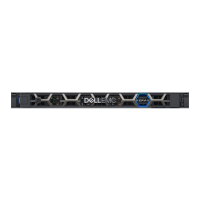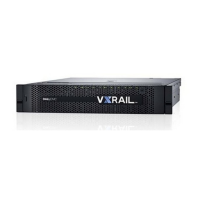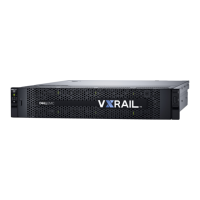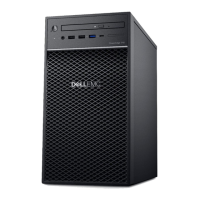27 | Network Planning Guide
© 2018 Dell Inc. or its subsidiaries
Step 3.
If applicable, configure the VxRail Cluster Build Network VLAN (Row 44) on the spine switch
Step 4.
If applicable, configure the VxRail Witness Traffic Separation Network VLAN (Row 50) on the spine switch
Step 5.
Create a logical pair (port channel) on the spine switch ports that will connect downstream to the uplinks on the
TOR switch.
o Make sure the port channel settings (active/passive) on the spine switch will match the setting on the TOR switch
o Configure all of the external VLANs on this port channel
Step 6.
Create logical pairs (port channels) as necessary to direct VxRail network traffic to the appropriate end
destination
Setting up the network switch for VxRail connectivity
You may skip this section if you plan to enable Dell-EMC SmartFabric services, and extend VxRail automation to
the TOR switch layer
For the VxRail initialization process to pass validation and build the cluster, you must configure the ports that VxRail will connect
to on your switch before you plug in VxRail nodes and powering them on.
Set up your switch by following these steps:
1. Plan switch configuration
2. Plan switch port configuration
3. Configure ports and VLANs on your switch(es)
NOTE:
This section provides guidance for preparing and setting up your switch for VxRail. Be sure to follow your vendor’s
documentation for specific switch configuration activities and for best practices for performance and availability.
Step 1. Plan Switch Configuration
Enable Multicast for VxRail Internal Management Network
VxRail Appliances have no backplane, so communication between its nodes is facilitated via the network switch. This
communication between the nodes uses VMware’s Loudmouth auto-discovery capabilities, based on the RFC-recognized "Zero
Network Configuration" protocol. New VxRail nodes advertise themselves on the network using the VMware Loudmouth service,
and are discovered by VxRail Manager with the Loudmouth service. VMware’s Loudmouth service depends on IPv6 multicast, and
IPv6 multicast is required for the VxRail internal management network.
The network switch ports that connect to VxRail nodes must allow for pass-through of multicast traffic on the VxRail Internal
Management VLAN. Multicast is not required on your entire network, just on the ports connected to VxRail nodes.
VxRail creates very little traffic via IPv6 multicast for auto-discovery and device management. It is recommended to limit traffic
further on your switch by enabling MLD Snooping and MLD Querier.
If MLD Snooping is enabled, then MLD Querier must be enabled. If MLD Snooping is disabled, then MLD Querier must be disabled.
For VxRail clusters running at version 4.7 or later, VxRail management traffic is segmented into two separate logical networks: one
which is external to service administrators and end users, and a second internal network used solely for auto-discovery and device
management, and is isolated from the upstream network. Multicast needs to be enabled only on this second internal management
network.
Enable Unicast or Multicast for VxRail vSAN Network
Starting in VxRail Release 4.5.0, all vSAN traffic replaces multicast with unicast. This change helps to reduce network configuration
complexity and simplifies switch configuration.

